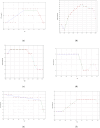The Impact of COVID-19 on DTP3 Vaccination Coverage in Europe (2012-2023)
- PMID: 39852785
- PMCID: PMC11768563
- DOI: 10.3390/vaccines13010006
The Impact of COVID-19 on DTP3 Vaccination Coverage in Europe (2012-2023)
Abstract
Background: The COVID-19 pandemic disrupted routine child immunization efforts, threatening to reverse progress in controlling vaccine-preventable diseases.
Materials and methods: We analyzed the impact of COVID-19 on DTP3 vaccination in Europe by comparing trends before and after the pandemic using time series data from 2000 to 2023. Employing joinpoint regression, chi-square tests, and segmented regression analysis, we assessed DTP3 vaccination trends and coverage changes.
Results: The findings revealed significant regional disparities across Europe. Statistical models indicated reductions in DTP3 coverage in countries such as Ireland, Sweden, and Switzerland, whereas Ukraine and San Marino showed improvements.
Conclusions: There are variations in the effect of COVID-19 on DTP3 coverage rates, indicating the need for targeted public health strategies to address vaccine hesitancy, logistical barriers, and systemic inequities.
Keywords: COVID-19 pandemic impact; DTP3 vaccination; Europe; vaccination trends.
Conflict of interest statement
The authors declare no conflicts of interest.
Figures















Similar articles
-
Has COVID-19 Affected DTP3 Vaccination in the Americas?Vaccines (Basel). 2024 Feb 25;12(3):238. doi: 10.3390/vaccines12030238. Vaccines (Basel). 2024. PMID: 38543872 Free PMC article.
-
Estimating global and regional disruptions to routine childhood vaccine coverage during the COVID-19 pandemic in 2020: a modelling study.Lancet. 2021 Aug 7;398(10299):522-534. doi: 10.1016/S0140-6736(21)01337-4. Epub 2021 Jul 17. Lancet. 2021. PMID: 34273292 Free PMC article.
-
COVID-19 Impact on DTP Vaccination Trends in Africa: A Joinpoint Regression Analysis.Vaccines (Basel). 2023 Jun 15;11(6):1103. doi: 10.3390/vaccines11061103. Vaccines (Basel). 2023. PMID: 37376492 Free PMC article.
-
The impact of COVID-19 and catch-up strategies on routine childhood vaccine coverage trends in Latin America: A systematic literature review and database analysis.Hum Vaccin Immunother. 2022 Nov 30;18(6):2102353. doi: 10.1080/21645515.2022.2102353. Epub 2022 Sep 9. Hum Vaccin Immunother. 2022. PMID: 36084255 Free PMC article.
-
Vaccine hesitancy and equity: lessons learned from the past and how they affect the COVID-19 countermeasure in Indonesia.Global Health. 2024 Feb 6;20(1):11. doi: 10.1186/s12992-023-00987-w. Global Health. 2024. PMID: 38321478 Free PMC article. Review.
Cited by
-
The Re-Emergence of Pediatric Pertussis: Insights from a Regional Romanian Hospital.Antibiotics (Basel). 2025 Jul 21;14(7):730. doi: 10.3390/antibiotics14070730. Antibiotics (Basel). 2025. PMID: 40724031 Free PMC article.
References
-
- Bramer C.A., Kimmins L.M., Swanson R., Kuo J., Vranesich P., Jacques-Carroll L.A., Shen A.K. Decline in Child Vaccination Coverage During the COVID-19 Pandemic—Michigan Care Improvement Registry, May 2016–May 2020. MMWR Morb. Mortal. Wkly. Rep. 2020;69:630–631. doi: 10.15585/mmwr.mm6920e1. - DOI - PubMed
-
- Abdulrasheed N., Lawal L., Mogaji A.B., Abdulkareem A.O., Shuaib A.K., Adeoti S.G., Amosu O.P., Muhammad-Olodo A.O., Lawal A.O., Jaji T.A., et al. Recurrent diphtheria outbreaks in Nigeria: A review of the underlying factors and remedies. Immun. Inflamm. Dis. 2023;11:e1096. doi: 10.1002/iid3.1096. - DOI - PMC - PubMed
LinkOut - more resources
Full Text Sources

